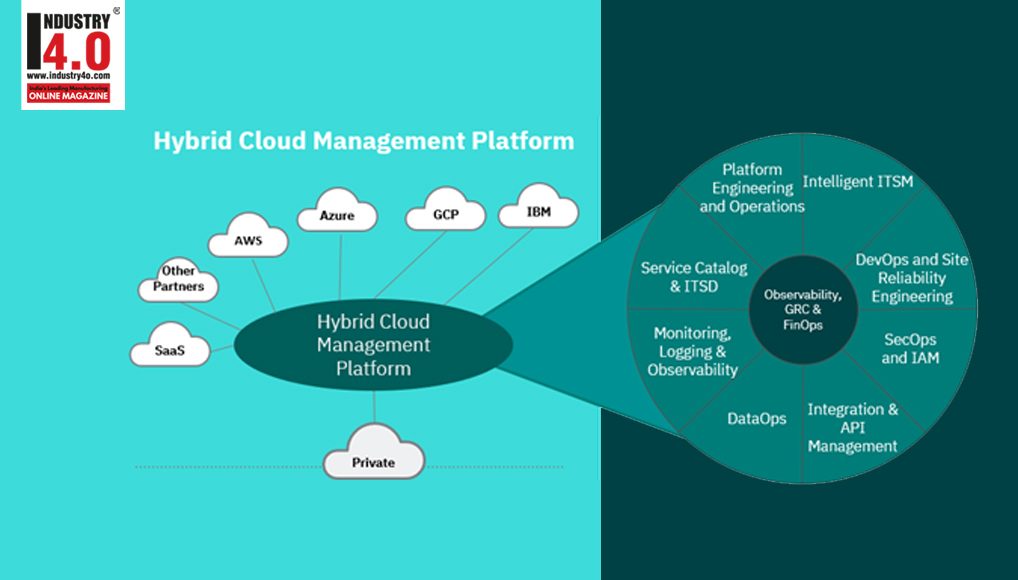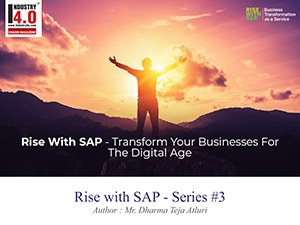FinOps : The Good, Bad and the Ugly
In recent years we have seen IT environments and related processes has changed significantly. Cloud adoption services are accelerated by multi-fold. One can say that in a way, the future arrived earlier than expected. Post COVID Digital transformation have been accelerated as enterprise’s sees renews the demand.
It is quite evident that most of enterprises are moving away from their traditional on-prem hosting to public cloud. As more organizations are adopting hybrid, multi-cloud patterns, they are struggling to optimize the value and to control cloud spend. Which in turn also has resulted in capital expenditure getting converted into operational expenses. As per Gartner report, by 2025, Enterprise spending from traditional IT will decrease and it will overtake by Cloud operational expenses.
Public cloud / Hybrid cloud consumption continues to grow at an exponential pace and CIOs across the enterprises are challenged with attaining the desired cost savings of migration to the cloud. Below are some of the key questions you need to consider
– How do we manage spiraling cloud costs and ensure we are making the most effective and efficient use of cloud services, in a pro-active manner?
– How do we ensure we are getting the most value from our cloud investments and getting the most business value from our cloud spend?
– How do we get our organization speaking the same language when it comes to cloud spend, especially between finance, IT and the business and are aligned around a common direction?
Need for a new approach to managing the Hybrid Cloud?
CXO’s are looking for the next generation Hybrid Cloud Operating Model that is enabled by the best Hybrid Cloud Management Platform, Automation, AIOps, Intelligent workflows and cloud native practices such as DevSecOps and Site Reliability Engineering delivered at enterprise scale.
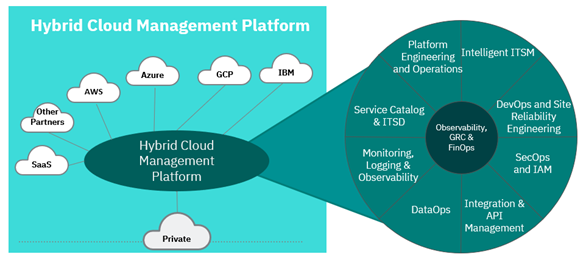
Below are some of the common cloud cost management issues which clients are dealing with today
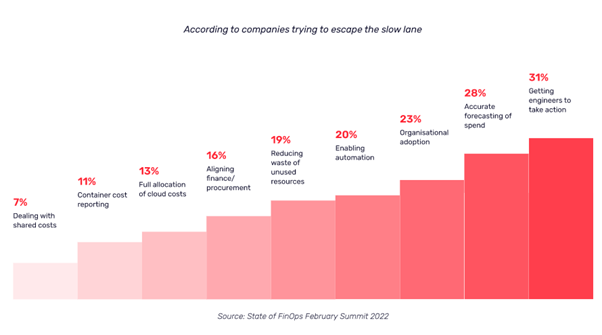
What is FinOps?
FinOps is the practice of bringing together Finance, Technology, and Business to manage the enterprise cloud Operational expenses for Cloud Cost Management. FinOps is also known as the operating model for efficient cloud usage. By understanding FinOps enterprise, can look at the opportunity to bring cost savings identified through potential reductions and to make smart informed decisions to improve the value obtained from your cloud deployment with reduction of TCO.
FinOps leverages the pricing through consolidated reporting and metrics which are validated by each of the business units within the enterprise. FinOps brings financial accountability within the organizations over hyperscale’s spending through a framework of best practices, and culture within the enterprise.
Qualification of when / why to adopt FinOps:
How can you confirm if FinOps is right for you?
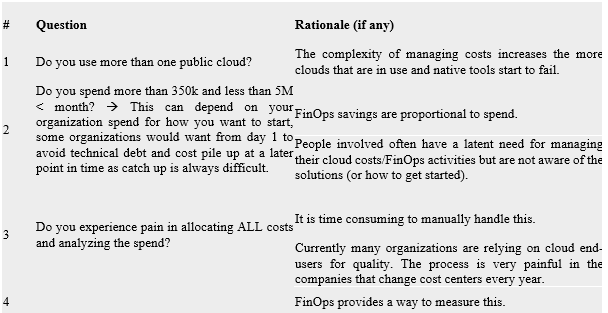
Challenges:
Enterprise as they journey to Cloud, some of the key challenges they face are listed here:
1. Resources provisioning: Enterprise needs to keep a check on the resources deployed and used by the development teams. If the development teams provision resource which are unused or when you reserve instances could impact directly on the resource wastage and rising up the operational cost.
2. Resource tagging: As the DevOps teams deploy cloud services, it is advised to follow proper resource tagging practices within the enterprise. If the development teams deploy numerous resources, it would be difficult to identify the cost of resource allocated.
3. Resource Monitoring: Monitoring of every resource deployed with in the enterprise mandate would allow the teams to validate underutilization or over utilization of resources.
4. Shared resources: When the cloud services or resources are used by multiple departments and the development done across the department would build multiples or duplicate resources or common services which would drive the cloud cost.
5. Accountability: When the department within the enterprise does not has ownership within the teams. Lack of governance to validate cloud services and resources deployed as a part of the software development life cycle, might drive the cloud cost factor.
6. Rightsizing of the cloud resources: If the enterprise fails to validate the cloud resources without proper sizing might impact on the Cloud Cost increase.
7. Resource Auto-scaling: Cloud demand based scaling needs to be validated depending on the business requirements which might drive the cost factor high if un noticed.
8. Resources purchases: Reservation of resources and committed for long term usage without the enterprise needs is other factor which might lead into cost bust.
Why FinOps is Ugly, Bad and Good?
FinOps as Ugly:
Without having the right understanding and the scope, adoption of FinOps can cause more pain than gain due to the fact you might oversee certain spend patterns which might not be evident with manual analysis but can cause a heavy slippage from a spend point of view. Lack of real time visibility into the cloud spend by well-orchestrated agents (bots) can result in resource wastage and increased cost. You can also end up having security breaches or regulatory compliance issues due to incorrect services being cut down jeopardizing the integrity of your business. Last but not the least, by cutting down on services relevant for feature development, you might be ending up increasing the time to market causing you to lose out on opportunities thus reducing the capitalization on market demands.
It is important to have a clear point of view on the objectives based on the questions set out earlier in this article of what your objectives are and how you are going to set out with over a period of time instead of trying to execute everything from day 1 and having the right people, process and technology angle to validate the changes and their impact on the consumption model along with the usability.
Hence, scaling your approach towards FinOps is very important by crawling, walking and running to ensure the foundation is set appropriately. Below is an overview of how you can scale your FinOps journey:
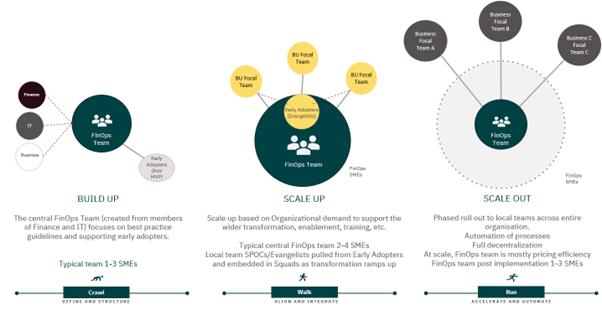
FinOps as Bad:
Most of you already have been thinking about FinOps in different ways today and they tend to be not cost effective by identifying the root cause as these are more focused on temporary band-aids being applied instead of permanent fixes to be put into place to ensure well defined responsibilities along with the culture and technology are introduced into your organization. Some of the things you tend to do today are
– Periodic review: Existing IT teams come together to address any performance issues being happening in the landscape due to sizing or overspending happening based on the finance teams complaining about the same. This won’t get your enough mileage as you are always in firefighting mode instead of being pro-actively looking for self-optimization techniques possible.
– Architecture patterns: On a regular basis, you keep updating your architectural patterns based on new features and native services being offered by the hyperscalers. This won’t help you with measuring the success as there are no KPIs associated to be able to identify what is causing the issues as the patterns introduced might only add more complexity to the existing solution.
– Outside SMEs brought over: You bring in external SMEs to do a review which will cost you heavily due to all the “bringing up to speed” effort along with the one-time recommendations but contributing towards ongoing pile up and doing this every time is not a recommended approach.
To avoid these temporary fixes, it is recommended to have well defined KPIs and benchmarking along with processes which can consume real time insights being generated along with measurable outcomes.
There are also known scenarios where the whole responsibility of FinOps is given to one central team making them responsible for monitoring of the spend, optimization and for the selection of right services across cloud to avoid duplication. The problem with this is, you have teams who have no visibility of the change being planned to cause more noise in the landscape and downstream impact on the ability to deliver services eventually adding up to dissatisfaction with the business and more silos being created for local business unit requirements.
It is key to have the activities federated across the organization instead of clustering them into one team to avoid the above-mentioned issues. FinOps is a team-game and needs skills from different teams through out your organization. Below is a summary of the proposed ownership structure with different teams to be considered (might differ for each organization based on the size of cloud adoption)

FinOps as Good:
FinOps goes hand in hand with DevOps and can be a radical transformation for some organizations. This requires a revised approach to cost and value management impacting the organizations to think beyond the comfort level they tend to adopt over a period of time to constantly innovate. For this to happen, the development teams, product owners, finance and commercial need to collectively re-think and re-imagine how they work and collaborate.
What is the value of adopting FinOps?
Below are some of the value statements and sample KPIs due to adoption of FinOps in your organization
– Control Organizational costs and provide consistency
o Average price per hour of compute
o Reduced Licensing costs
o Reduced total cost of ownership
o Idle instances > 30 days and Idle instances < 30 days
– Drive better outcomes and performance with leadership visibility and planning
o Total bill vs forecast – including variance % of forecast: actual bill
o Architecture in compliance with business objectives and technology directions
o Increase in automation and tagging
– Operational excellence through speed of decisions
o Reduced time taken to create demand forecast
o Faster “go” and “no-go” decisions for business cases
o Less time taken to provide virtual capacity on-demand
– Align Business and IT goals for enhanced exiting and new capabilities
o Increase in connected enterprise goal setting
o Robust business case development with qualified business benefits
Solution:
It is important to have a clear journey path laid out with the points mentioned so far by defining the current state, establishing the future state and then coming up with the transition on how you are going to evolve from the current to the future state while having a clear execution plan. To make it a repeatable process for different organizations / business units within your organization it important to have well laid out design principles to help you along with consistency of adoption and KPIs on what you would be monitoring. Below are some of the key design principles:
FinOps – Design Principles : Below are some of the key design principles you need to think about around adoption of FinOps (these are in line with the six core principles defined by FinOps foundation guide activities – https://www.finops.org/framework/principles/)
1. Organization wide support is paramount across business and IT equally
2. Cloud decisions should be driven by business scenarios rather than IT owned initiatives
3. Equal responsibility for the cloud compute and services usage
4. FinOps reports should be up accessible and timely
5. A centralized ownership for the KPIs put forward
6. Actively manage the ongoing drift in the usage and spend
Along with the design principles, it is also important to be aware of the different phases for FinOps and capabilities expected across those phases,
– FinOps has three phases called out as Inform, Optimize and Operate
o Inform phase: Provides cost insight allowing for proper allocation of resources, smart decision making and promotes cross functional accountability
o Optimize phase: Encourages cost efficiencies by empowering teams to make the best and effective use of cloud services striking the right balance between performance and cost
o Operate phase: Continuous improvements of operations and governance to ensure alignment with ever-evolving business goals and scale and run services in a way that lowers the overall cloud TCO and delivers most value
In line with the phases, let’s now have a look at the FinOps capabilities:

In summary below are key actions to be planned:
· Take benefits of cloud purchase discounts
Enterprises often purchase cloud services on long term on different purchase options like reservations, volume discounts and most commonly opt for Reserved instances. One need to plan intelligently to make use of the options in such way to produce maximum cloud savings.
Enterprise needs to review minute cloud licensing terms, payment terms, contract terms. Enterprise Architect must need to take into consideration, resources, and processing demand over long term, as this could save lot of money.
· Schedule suspension of orphaned resources
One study revel that annually as much as $2.6bn in cloud spend goes in orphaned or “Zombie” resources. To make things worse, many of non-production resources end up running in the cloud for 24×7. This is huge cloud budget going in waste.
Often enterprises are built the servers especially in and as experiment, development, or test purpose. These virtual servers remain idle, cloud resources connected to these servers, and snapshots to disks that don’t exist anymore are all examples of orphaned or “zombie” cloud resources — and they could be eating away at enterprises cloud budget. Many of these resources don’t need to be running in the cloud non-stop.
Instead, implement scheduled suspension for non-production workloads. One can even automate the process.
· Leverage automation
Enterprises should consider the automation of processes while developing and maintaining a hybrid cloud. Processes like resource provisioning, application deployment, and performance monitoring should be automate. Irrespective of where the workload runs, cloud native tools like CloudHealth, CloudCheckr, CloudBolt etc will help manage and monitor cloud costs. In fact, these tools help simplify and streamline operations.
• Automation, including workload lifecycle automation, and automated provisioning.
• Cloud optimisation on cost and performance.
• Cloud monitoring on cost, performance, and capacity.
Finally, the key question to consider, is there a roadmap to get to the stage of “nirvana”? Below is a sample of different patterns you can consider when going about with your journey of FinOps for your organization.

Some of the toolsets you can think about to achieve these are Apptio, Klarity, Instana, Splunk, Moogsoft, Turbonomic, Ansible / Terraform / Selenium, Celonis / Signavio / IBM Process Mining / Worksoft, ServiceNow, Cloud provider native services along with other tools such as BLUECAT.
About the Author :

Mr. Dharma Teja Atluri is a Global Chief Technology Officer – SAP Manage Services, RISE with SAP & ManagePlus, Inventor and Artificial Intelligence / Machine Levangelist at IBM. He has more than 19 years of experience working in advanced analytics with both SAP and non-SAP product lines. He has provided strategic direction to clients globally regarding the adoption of SAP and non-SAP advanced analytics products for artificial intelligence/machine learning operationalization, data management, information management, and analytics. He has also carried out multiple platform comparison initiatives for reporting, ETL, data warehousing, and data science products across IBM, Microsoft Azure, Google, Amazon Web Services, and SAP. He has led the SAP analytics (reporting and enterprise information management) portfolio for IBM India, and designed client architectures for analytics with SAP and IBM capabilities. Dharma is an IBM master certified data scientist, architect, and technical specialist, and also an IBM thought leader certified consultant. His most recent SAP Data Intelligence sprint was featured for global consumption by clients and nominated for SAP Innovation Awards.
Mr. Dharma Teja Atluri is currently leading the RISE with SAP as a Chief Architect enabling Technical Managed Services on IBM Cloud along with Other Hyperscalers to support the clients on their journey towards Hybrid Cloud with Automation, Data and Intelligent Workflows driven by Artificial Intelligence (AI).
Mr. Dharma Teja Atluri is the Chapter Lead & Co-Chair of TEC India & Member of IBM Academy of Technology.
Mr. Dharma Teja Atluri is bestowed with the following License & Certifications :
https://www.linkedin.com/in/dh
Mr. Dharma Teja Atluri has received following Honors & Awards :
https://www.linkedin.com/in/dh
https://www.credly.com/users/dharma-teja-atluri/badges
Mr. Dharma Teja Atluri can be Contacted at :
Email | LinkedIn | Twitter | Skype : darma.teja
Also read Mr. Dharma Teja Atluri’s earlier articles:

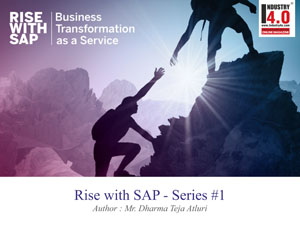
 https://www.sap-press.com/sap-data-intelligence_5369/
https://www.sap-press.com/sap-data-intelligence_5369/

